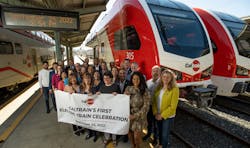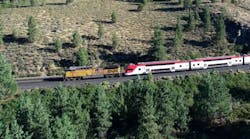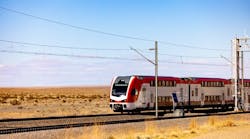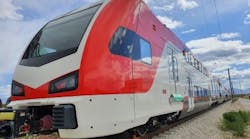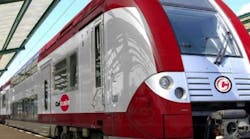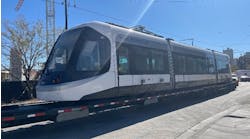Public gets first glimpse at Caltrain’s new electric trainsets
Caltrain provided the first public viewing of its new electric train cars on Saturday, Sept. 24, at an event attended by federal, state, regional, local officials and community members. Caltrain calls the new train cars the centerpiece of its electrification project, which not only brings a new power source to the Caltrain fleet, but will also deliver an increase in service and train speeds.
“The electrification of Caltrain is one of the most important milestones in Caltrain’s history,” said Caltrain Board Chair Steve Heminger. “Being able to step onto the new trains for the first time makes me even more excited for the start of electrified service in 2024.”
The project will electrify a 51-mile corridor from San Francisco’s 4th and King Caltrain Station to the Tamien Caltrain Station and replace 75 percent of Caltrain’s diesel service with electric.
In July 2016, Stadler US, Inc., was awarded a contract to manufacture the new electric multiple unit (EMU) trainsets. The 19 trainsets will offer smoother quieter rides and additional capacity. The cars include passenger experience enhancements such as on-board signage, roomier seats, power sources at every fixed seat, ADA-compliant restrooms, additional storage space and two dedicated bike cars per seven-car trainset.
“We are always proud when a new audience is introduced to our trains,” said Martin Ritter, CEO of Stadler US. “Today, the Bay Area will see a modern train, designed for comfort, efficiency and sustainability, and I hope they are similarly proud to be served by these trains.”
The first EMU was assembled at Stadler’s Salt Lake City facility in 2020 and was tested in Pueblo, Colo., before arriving at Caltrain. Once the EMUs arrive in California, they will undergo additional testing before they enter passenger service in 2024.
“We are excited for the first electric trains that will speed down the Caltrain tracks, carrying a future generation of transit riders across the Bay Area,” said Federal Transit Administration (FTA) Regional Administrator Ray Tellis. “Creating the opportunity for more cleaner and higher capacity trains every hour means better service for riders. Electrifying those trains means a smoother ride, better air quality and another step toward addressing climate change. Congratulations, and thank you to Caltrain for being a great partner.”
FTA and Caltrain executed a Full Funding Grant Agreement in May 2017 for $647 million through FTA’s Capital Investment Grants Program for the electrification project. Federal formula funds, as well as state bonds, grants and local funds will help pay for the project. In the summer of 2021, Caltrain announced pandemic-related supply chain challenges, as well as challenging signal systems installation that resulted in cost increases on the electrification project, as well as a delayed service start date from the second quarter of 2022 until late 2024. Caltrain explains the project requires an additional $462 million to complete and it is working with its partners and stakeholders to bridge the gap.
In addition to improving service, Caltrain notes electrification will also help meet ambitious regional and state climate action goals by lowering greenhouse gas emissions, improving air quality and relieving traffic congestion. Additionally, electrified service will advance equity along the corridor by reducing noise and air pollution while increasing access for priority equity neighbors. It will also set the framework for California’s future High Speed Rail network.
“An electrified Caltrain is a momentous accomplishment – not just for the Bay Area but the entire state,” said California Transportation Secretary Toks Omishakin. “From cleaner air to enhanced speed and safety, the mobility, environmental, equity and economic benefits are immense. California is leading the nation in rapidly electrifying our transportation system and Caltrain is at the front of the pack.”

Mischa Wanek-Libman | Group Editorial Director
Mischa Wanek-Libman is director of communications with Transdev North America. She has more than 20 years of experience working in the transportation industry covering construction projects, engineering challenges, transit and rail operations and best practices.
Wanek-Libman has held top editorial positions at freight rail and public transportation business-to-business publications including as editor-in-chief and editorial director of Mass Transit from 2018-2024. She has been recognized for editorial excellence through her individual work, as well as for collaborative content.
She is an active member of the American Public Transportation Association's Marketing and Communications Committee and served 14 years as a Board Observer on the National Railroad Construction and Maintenance Association (NRC) Board of Directors.
She is a graduate of Drake University in Des Moines, Iowa, where she earned a Bachelor of Arts degree in Journalism and Mass Communication.
